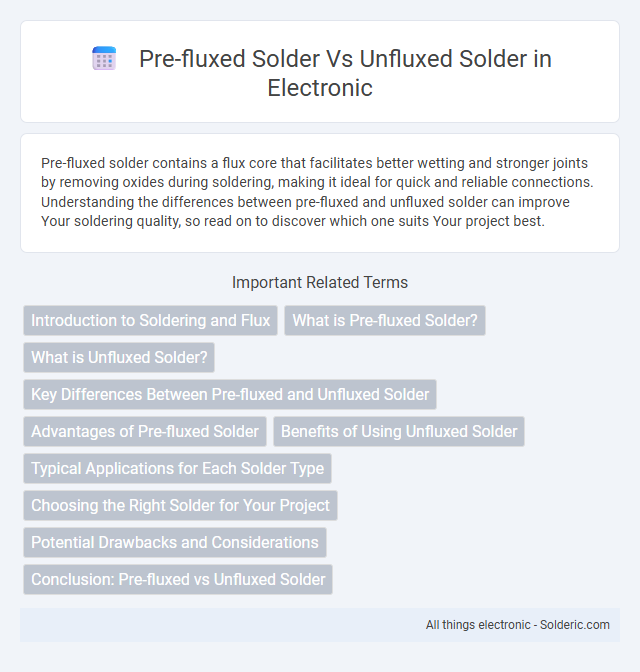Pre-fluxed solder contains a flux core that facilitates better wetting and stronger joints by removing oxides during soldering, making it ideal for quick and reliable connections. Understanding the differences between pre-fluxed and unfluxed solder can improve Your soldering quality, so read on to discover which one suits Your project best.
Comparison Table
| Feature | Pre-Fluxed Solder | Unfluxed Solder |
|---|---|---|
| Definition | Solder wire with flux core integrated | Solid solder wire without flux |
| Flux Type | Rosin-based or no-clean flux inside core | Requires external flux application |
| Usage Convenience | Easy to use, self-fluxing during soldering | Needs manual flux application before soldering |
| Oxide Removal | Effective oxide removal due to internal flux | Dependent on external flux quality and application |
| Ideal Application | Electronic PCB assembly, delicate joints | General metalwork requiring specialized flux |
| Cost | Typically higher due to integrated flux | Generally lower, but cost increases with added flux |
| Cleanliness | Often leaves minimal residue (no-clean types) | Requires cleaning after soldering to remove flux residues |
Introduction to Soldering and Flux
Pre-fluxed solder contains a built-in flux core that facilitates the removal of oxide layers during the soldering process, ensuring strong metal joint adhesion and improved electrical conductivity. Unfluxed solder requires the application of an external flux to achieve similar oxidation prevention and enhance solder flow. Understanding the role of flux in breaking down oxides and promoting wetting is essential for effective soldering and long-lasting electronic connections.
What is Pre-fluxed Solder?
Pre-fluxed solder contains a flux core that actively cleans and prepares metal surfaces during the soldering process, enhancing the bond strength and reducing oxidation. This flux core eliminates the need for separate flux application, saving time and improving efficiency in electronic assembly or plumbing tasks. When using pre-fluxed solder, Your work benefits from cleaner joints and more reliable connections compared to unfluxed solder, which requires separate flux to achieve similar results.
What is Unfluxed Solder?
Unfluxed solder is a type of solder wire that does not contain any flux core, requiring separate application of flux during the soldering process to ensure proper metal bonding and oxidation prevention. This solder is often preferred in applications where controlled flux application is necessary or when working with materials sensitive to flux residues. Without internal flux, unfluxed solder provides greater flexibility but demands more careful preparation and technique to achieve strong, clean joints.
Key Differences Between Pre-fluxed and Unfluxed Solder
Pre-fluxed solder contains a flux core that facilitates better adhesion and cleaner joints by preventing oxidation during the soldering process, whereas unfluxed solder requires separate application of flux, adding an extra step for effective bonding. Pre-fluxed solder is ideal for quick, precise repairs and electronics work, while unfluxed solder offers more control over the flux amount and type, enabling customization for specialized tasks. Choosing the right solder impacts Your project's efficiency and joint reliability depending on the flux requirements and complexity of the soldering job.
Advantages of Pre-fluxed Solder
Pre-fluxed solder offers the advantage of improved wetting and stronger joint formation by containing flux within the solder core, which eliminates the need for separate flux application and reduces contamination risks. This type of solder simplifies the assembly process, increases efficiency, and enhances the reliability of electronic circuits by minimizing flux residue and ensuring consistent solder flow. It is particularly beneficial in automated soldering systems and precision electronics manufacturing where cleanliness and precision are critical.
Benefits of Using Unfluxed Solder
Unfluxed solder offers the key benefit of avoiding chemical residues that can cause corrosion or require additional cleaning after soldering, making it ideal for sensitive electronic components and aerospace applications. It provides cleaner joints in environments where flux residues could interfere with electrical performance or long-term reliability. This type of solder is preferred when working on delicate circuitry that demands minimal contamination for enhanced durability and functionality.
Typical Applications for Each Solder Type
Pre-fluxed solder is typically used in electronics manufacturing and repair where precise, clean joints are required without the need for additional flux application, making it ideal for small-scale or delicate components. Unfluxed solder is often preferred in plumbing, HVAC, and mechanical applications where a separate flux can be applied to ensure better adhesion and corrosion protection on larger or metal surfaces. Your choice depends on whether you need convenience and neatness for fine electronics or stronger, more flexible bonding for robust metalwork.
Choosing the Right Solder for Your Project
Choosing the right solder for your project depends on the specific application and ease of use required; pre-fluxed solder contains a built-in flux core that simplifies the soldering process by cleaning and preparing the metal surfaces, reducing oxidation. Unfluxed solder, on the other hand, requires separate application of flux to ensure strong, reliable joints, offering greater control for complex or precision work. Your choice between pre-fluxed and unfluxed solder impacts the quality, workflow efficiency, and overall durability of the soldered connections.
Potential Drawbacks and Considerations
Pre-fluxed solder can leave behind residue that may cause corrosion or require additional cleaning, posing reliability concerns for sensitive electronics. Unfluxed solder demands external flux application, which increases process complexity but allows greater control over flux quantity and placement. Both types require proper handling to avoid issues like poor wetting, joint weakness, or contamination during soldering.
Conclusion: Pre-fluxed vs Unfluxed Solder
Pre-fluxed solder contains a built-in flux core that simplifies the soldering process by removing oxides and promoting better metal adhesion, making it ideal for quick repairs and electronic assembly. Unfluxed solder requires an external flux application, offering more control over flux quantity and type, which is beneficial for specialized or high-precision soldering tasks. Choosing between pre-fluxed and unfluxed solder depends on your project's complexity, as pre-fluxed solder enhances efficiency while unfluxed solder allows customization for optimal joint quality.
Pre-fluxed solder vs unfluxed solder Infographic

 solderic.com
solderic.com